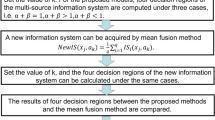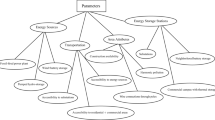Abstract
Probabilistic rough set model and graded rough set model are used to measure relative quantitative information and absolute quantitative information between equivalence classes and basic concepts, respectively. Since fuzzy concepts are more common in real life than classical concepts, how to use relative and absolute quantitative information to determine fuzzy concepts is a extremely important research topic. In this study, we propose a double-quantitative decision theory rough fuzzy set frame based on the fusion of decision theory rough set and graded rough set, and the framework mainly studies the fuzzy concepts in multigranulation approximation spaces. Three pairs of double-quantitative multigranulation decision theory rough fuzzy set models are established. Some basic characteristics of these models are discussed. The decision rules including relative and absolute quantitative information are studied. The intrinsic relationship between the double-quantitative decision theory rough fuzzy set and the multigranulation rough set is analyzed. Finally, an illustrative case of medical diagnosis is conducted to explain and evaluate the dual quantitative decision theory approach.
Similar content being viewed by others
References
Pawlak Z (1982) Rough set. Int J Comput Inf Sci 11(5):341–356
Pawlak Z (1991) Rough sets: theoretical aspects of reasoning about data. Kluwer Academic, Dordrecht
Zhao XR, Hu BQ (2016) Fuzzy probabilistic rough sets and their corresponding three-way decisions. Knowl Based Syst 91:126–142
Zhang XH, Miao DQ, Liu CH, Le ML (2016) Constructive methods of rough approximation operators and multigranulation rough sets. Knowl Based Syst 91:114–125
Zhang YL, Li CQ, Lin ML, Lin YJ (2015) Relationships between generalized rough sets based on covering and reflexive neighborhood system. Inf Sci 319:56–67
Yao YY, Zhou B (2016) Two bayesian approaches to rough sets. Eur J Oper Res 251(3):904–917
Zhang QH, Zhang Q, Wang GY (2016) The uncertainty of probabilistic rough sets in multigranulation spaces. Int J Approx Reason 77:38–54
Liang JY, Chin KS, Dang C et al (2002) A new method for measuring uncertainty and fuzziness in rough set theory. Int J Gen Syst 31(4):331–342
Chen DG, Kwong S, He Q, Wang H (2012) Geometrical interpretation and applications of membership functions with fuzzy rough sets. Fuzzy Sets Syst 193:122–135
Tan AH, Li JJ, Lin GP (2015) Extended results on the relationship between information systems. Inf Sci 290:156–173
Liang JY, Wang JH, Qian YH (2014) A new measure of uncertainty based on knowledge granulation for rough sets. Inf Sci 26(2):294–308
Wu WZ, Zhang M, Li HZ, Mi JS (2005) Knowledge reduction in random information systems via Dempster-Shafer theory of evidence. Inf Sci 174(3):143–164
Zhu W (2009) Relationship among basic concepts in covering-based rough sets. Inf Sci 179(14):2478–2486
Zhu W, Wang SP (2013) Rough matroids based on relations. Inf Sci 232:241–252
Tan AH, Wu WZ, Li JJ, Lin GP (2016) Evidence-theory-based numerical characterization of multigranulation rough sets in incomplete information systems. Fuzzy Sets Syst 294:18–35
Wang GY, Ma XA, Yu H (2015) Monotonic uncertainty measures for attribute reduction in probabilistic rough set model. Int J Approx Reason 59:41–67
Xue Z, Zeng X, Koehl L, Chen Y (2014) Measuring consistency of two datasets using fuzzy techniques and the concept of indiscernibility: application to human perceptions on fabrics. Eng Appl Artif Intell 36:54–63
Chen DG, Li WL, Kwong S (2014) Evidence-theory-based numerical algorithms of attribute reduction with neighborhood-covering rough sets. Int J Approx Reason 55(3):908–923
Chen DG, Zhang XX, Li WL (2015) On measurements of covering rough sets based on granules and evidence theory. Inf Sci 317:329–348
Pawlak Z, Wong SK, Ziarko W (1988) Rough sets: probabilistic versus deterministic approach. Int J Man Mach Stud 29(1):81–95
Wong SKM, Ziarko W (1987) INFER: an adaptative decision support system based on the probabilistic approximate classification. International workshop on expert systems and their applications, pp 713–726
Wong SKM, Ziarko W (1987) Comparison of the probabilistic approximate classification and the fuzzy set model. Fuzzy Sets Syst 21(3):357–362
Yao YY, Wong SKM, Lingras P (1990) A decision-theoretic rough set model. Methodologies for Intelligent Systems, North-Holland, New York
Pawlak Z, Skowron A (1994) Rough membership functions. Advances in the Dempster–Shafer Theory of Evidence. Wiley, New York, pp 251–271
Skowron A, Stepaniuk J (1996) Tolerance approximation spaces. Fund Inf 27:245–253
Slezak D, Ziarko W (2005) The investigation of the Bayesian rough set model. Int J Approx Reason 40:81–91
Herbert JP, Yao JT (2011) Game-theoretic rough set. Fund Inf 108:267–286
Yao YY, Zhou B (2010) Naive Bayesian rough sets. In: Proceedings of the 5th international conference on rough sets and knowledge technology, vol 6401. LNAI, pp 713–720
Zhang XY, Miao DQ (2015) An expanded double-quantitative model regarding probabilities and grades and its hierarchical double-quantitative attribute reduction. Inf Sci 299:312–336
Zhang XY, Miao DQ (2016) Double-quantitative fusion of accuracy and importance: systematic measure mining, benign integration construction, hierarchical attribute reduction. Knowl Based Syst 91:219–240
Zhang XY, Miao DQ (2013) Two basic double-quantitative rough set models for precision and graded and their investigation using granular computing. Int J Approx Reason 54:1130–1148
Zhang XY, Miao DQ (2014) Quantitative information architecture, granular computing and rough set models in the double-quantitative approximation space of precision and grade. Inf Sci 268(2):147–168
Zadeh LA (1979) Fuzzy sets and information granularity. In: Gupa N, Ragade R, Yager R (eds) Advances in fuzzy set theory and applications. North-Holland, Amsterdam, pp 3–18
Qian YH, Liang JY (2006) Rough set method based on multigranulations, ICCI2006, cognitiveinformatics. IEEE Int. Conf. Cognit. Inf. pp 297-304
Malyszko D, Stepaniuk J (2010) Adaptive multilevel rough entropy evolutionary thresholding. Inf Sci 180(7):1138–1158
Wu WZ, Leung Y (2011) Theory and applications of granular labelled partitions in multi-scale decision tables. Inf Sci 181(18):3878–3897
Qian YH, Liang JY, Yao YY, Dang CY (2010) Mgrs: a multi-granulation rough set. Inf Sci 180:949–970
Lin YJ, Li JJ, Lin PR, Lin GP, Chen JK (2014) Feature selection via neighborhood multigranulation fusion. Knowl Based Syst 67:162–168
Qian YH, Liang JY, Dang CY (2010) Incomplete mutigranulation rough set. IEEE Trans Syst Man Cybern Part A 40:420–431
Qian YH, Liang JY, Pedrycz W, Dang CY (2010) Positive approximation: an accelerator for attribute reduction in rough set theory. Artif Intell 174:597–618
Qian YH, Liang JY, Pedrycz W, Dang CY (2011) An efficient accelerator for attribute reduction from incomplete data in rough set framework. Pattern Recogn 44:1658–1670
Dai JH, Hu H, Wu WZ, Qian YH, Huang DB (2018) Maximal-discernibility-pair-based approach to attribute reduction in fuzzy rough sets. IEEE Trans Fuzzy Syst 26(4):2174–2187
Yang XB, Qi Y, Yu HL, Song XN, Yang JY (2014) Updating multigranulation rough approximations with increasing of granular structures. Knowl Based Syst 64:59–69
Dai JH, Xu Q (2013) Attribute selection based on information gain ratio in fuzzy rough set theory with application to tumor classification. Appl Soft Comput 13(1):211–221
Qian YH, Zhang H, Sang YL, Liang JY (2014) Multigranulation decision-theoretic rough sets. Int J Approx Reason 55:225–237
She YH, He XL (2012) On the structure of the multigranulation rough set model. Knowl Based Syst 36:81–92
Wu MF (2010) Fuzzy rough set model based on multi-granulations. Int Conf Comput Eng Technol 2010:271–275
Yang XB, Song XN, Dou HL (2011) Multi-granulation rough set: from crisp to fuzzy case. Ann Fuzzy Math Inf 1(1):55–70
Xu WH, Wang QR, Zhang XT (2011) Multi-granulation fuzzy rough set models on tolerance relations. In: Proceeding of The Fourth International Workshop on Advanced Computational Intelligence. Wuhan, Hubei, pp 359–366
Liu CH, Wang MZ (2011) Covering fuzzy rough set based on multigranulations. In: Proceedings of International Conference on Uncertainty Reasoning and Knowledge Engineering, pp 146–149
Liu CH, Miao DQ (2011) Covering rough set model based on multi-granulations, RSFD-GRc2011 87-90
Liang JY, Wang F, Dang CY, Qian YH (2012) An efficient rough feature selection algorithm with a multi-granulation view. Int J Approx Reason 53(6):912–926
Zadeh LA (1965) Fuzzy sets. Inf. Control 8(3):338–353
Sarkar M (2002) Rough-fuzzy functions in classification. Fuzzy Sets Syst 132(3):353–369
Yao YY, Lin TY (1996) Generalization of rough sets using modal logic. Intell. Autom. Soft Comput. 2(2):103–119
Yao YY, Wong SKM (1992) A decision theoretic framework for approximating concepts. Int J Man Mach Stud 37(6):793–809
Sun BZ, Ma WM, Zhao HY (2014) Decision-theoretic rough fuzzy set model and application. Inf Sci 283:180–196
Acknowledgements
This work is supported by the National Natural Science Foundation of China (No. 11771111) and the National Natural Science Foundation of CQ CSTC (No. CSTC 2015jcyjA40053).
Author information
Authors and Affiliations
Corresponding author
Additional information
Publisher's Note
Springer Nature remains neutral with regard to jurisdictional claims in published maps and institutional affiliations.
Rights and permissions
About this article
Cite this article
Li, M., Chen, M. & Xu, W. Double-quantitative multigranulation decision-theoretic rough fuzzy set model. Int. J. Mach. Learn. & Cyber. 10, 3225–3244 (2019). https://doi.org/10.1007/s13042-019-01013-5
Received:
Accepted:
Published:
Issue Date:
DOI: https://doi.org/10.1007/s13042-019-01013-5




